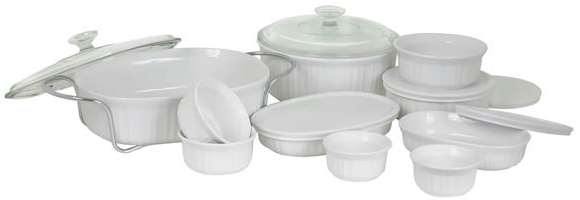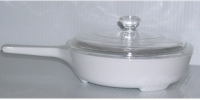
Equipment
None of the cookbooks I have read or demonstrations of microwave cooking I have seen have emphasized the point that the shape and size of the utensil in which the food is cooked determines how a recipe will turn out, but I have found this to be the case. Consequently, a person may follow a recipe to the letter with disastrous results because the directions vaguely stated, "Cook in a one-quart casserole."
When cooking in the microwave, all utensils should be placed in the center of the oven, whether you have an autorotating oven or not. This is so that the microwaves will be deflected evenly during the cooking process.
Weighing Food Produces Better Results
One piece of equipment essential for microwave cooking (especially for one or two) is a small, inexpensive diet scale. Measuring food by weight and not volume is the best method for microwave cooking because such measurement is exact and because the weight of an ingredient determines the length of time it will take to cook in the microwave. A small onion defies exact measurement; 1 ounce of onion, however is exact. A cup of sliced carrots can vary in weight according to the carrot's diameter and the thickness of the slices. Since most of these recipes require such small amounts, using exactly 2 ounces of carrots will assure uniform results. With the current emphasis on not wasting energy or food and the continuing popularity of slim waistlines, the diet scale should be an integral part of the new American way of cooking and eating. Therefore, before trying the recipes in Microwave Cooking for One, please buy a diet scale.
Size and Shape of the Utensil is Important
In order to prepare a recipe properly in a microwave oven, the utensil recommended in the cookbook should be used. If a different utensil is used and the recipe is followed faithfully but the results are poor, the failure can be attributed to the cooking utensil. You may safely substitute other utensils if the sizes and shapes are the same.
Keep in mind when choosing utensils to use in your microwave that round is better because the utensils with rounded edges will absorb microwave energy more evenly. It is also important to use the appropriate size dish indicated in a recipe.
For online resources for locating microwave utensils, visit our Shopping for Microwave Utensils section.
Is this Utensil Safe for the Microwave?
Most glass and ceramic dishes are safe for the microwave, but if you have your doubts, here is a simple way to test the dish. Place a cup full of water and the dish in question in your microwave. Cook at 100% power for one minute. If the water gets hot and the dish remains cool, it is safe to use in the microwave.
If the dish is hot that means the microwaves were attracted to lead or other metallic substance in the dish, and it is not safe to use in your microwave. Metal reflects the microwaves rather than letting them get into the dish to the food. You should also avoid cookware that has metallic trim on it. Microwave energy can become trapped in the trim and cause arching (sparks that can start a fire).
Browning is Possible in the Microwave
It is possible to brown meats, biscuits, and other items in the microwave. The trick is to have the proper utensil. When Microwave Cooking for One was first published, CorningWare produced quite an array of browning utensils ideal for cooking in the microwave. These utensils differ from other CorningWare products in that they have little feet to hold the bottom off the surface, and the bottom is coated with tin oxide. The browning utensil is the only utensil you should put in the microwave without food in it. You simply preheat the utensil for the time indicated in a recipe, and then place the meat on it and microwave the amount of time indicated. You can make a hamburger in less than four minutes, and cleaning the browning utensil is a lot easier than cleaning a frying pan.
Unfortunately, CorningWare determined that the public at large did not understand how to use these utensils, and therefore rarely purchased them. So they quit producing them. If you already own a CorningWare Browning utensil, here are the instructions for using browning utensils.
"I Can't Find The Corning Menu-ettes"
We've received several emails from purchasers of Microwave Cooking for One, looking for the CorningWare 1-pint and 1½-pint Menu-ettes. Alas, CorningWare no longer manufacturers this line. However, they do manufacture the CorningWare French White line that includes small casseroles, which are the same size and can easily be substituted. It is size and shape that matter, not the name of the dish to be used. Remembering our basic conversions, 1 pint is equal to 16 ounces, so 1½ pints would be equivalent to 24 ounces. CorningWare manufactures both a 16-ounce and a 24-ounce round casserole. For actual exactly the items described in the book you can Locate Menu-ettes here.
Clean Up is a Breeze
To clean any food encrusted on ceramic or glass utensils, put a small amount of dishwasher detergent in the utensil, add hot water, and allow to soak for half an hour. The utensil will rinse clean, and your kitchen cleanup time will be reduced considerably.
Microwave-Safe Dinnerware
One of the wonderful features of microwave cooking is that you can cook in the utensil you are going to serve in. Isn't it wonderful that so many popular lines of dinnerware, are also microwave-safe. When you want a quick bowl of oatmeal, why not cook it right in the bowl you're going to eat it out of? Why scrub pots and pans when you don't have to? We feature a lot of options in our Dinnerware section.
Other Useful Tips
- Know the wattage of your oven. Most published recipes are for 700-watt ovens, so if yours is less or more than 700 watts, learn how to increase or decrease cooking times. We offer handy Conversion Charts to help you adjust the cooking times.
- When you try a new recipe, jot down the results right on the recipe so that next time you will know the changes or adjustments you need to make.
- Cook frozen foods while still frozen unless a recipe gives directions for defrosting.
- Use only white paper towels and use them carefully. Don't put one in an empty hot browning dish or place the hot dish on one.
- Remove plastic wrap carefully from hot food. Lift up the farthest edge and pull it toward you so the steam will be released away from you.
- Use metal measuring cups for both liquid and dry measurements. The glass measuring cups normally used for liquid measurement allow too much variation in amounts, producing variations in result.
- Learn to use browning utensils properly. Leave the heated utensil in the oven between steps: it is safer, and heat is not lost by carrying the utensil back and forth.



SHARE THIS PAGE: